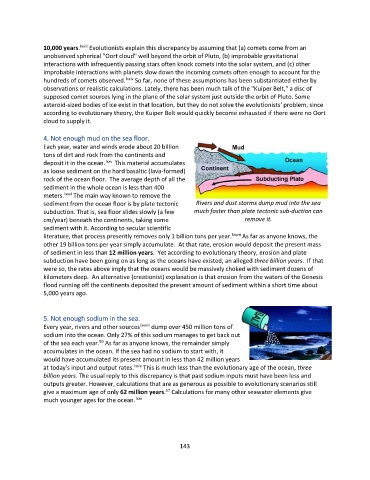Page 145 - Doctrine and History of the Preservation of the Bible revised
P. 145
10,000 years. lxxiii Evolutionists explain this discrepancy by assuming that (a) comets come from an
unobserved spherical "Oort cloud" well beyond the orbit of Pluto, (b) improbable gravitational
interactions with infrequently passing stars often knock comets into the solar system, and (c) other
improbable interactions with planets slow down the incoming comets often enough to account for the
hundreds of comets observed. lxxiv So far, none of these assumptions has been substantiated either by
observations or realistic calculations. Lately, there has been much talk of the "Kuiper Belt," a disc of
supposed comet sources lying in the plane of the solar system just outside the orbit of Pluto. Some
asteroid-sized bodies of ice exist in that location, but they do not solve the evolutionists' problem, since
according to evolutionary theory, the Kuiper Belt would quickly become exhausted if there were no Oort
cloud to supply it.
4. Not enough mud on the sea floor.
Each year, water and winds erode about 20 billion
tons of dirt and rock from the continents and
deposit it in the ocean. lxxv This material accumulates
as loose sediment on the hard basaltic (lava-formed)
rock of the ocean floor. The average depth of all the
sediment in the whole ocean is less than 400
meters. lxxvi The main way known to remove the
sediment from the ocean floor is by plate tectonic Rivers and dust storms dump mud into the sea
subduction. That is, sea floor slides slowly (a few much faster than plate tectonic sub-duction can
cm/year) beneath the continents, taking some remove it.
sediment with it. According to secular scientific
literature, that process presently removes only 1 billion tons per year. lxxvii As far as anyone knows, the
other 19 billion tons per year simply accumulate. At that rate, erosion would deposit the present mass
of sediment in less than 12 million years. Yet according to evolutionary theory, erosion and plate
subduction have been going on as long as the oceans have existed, an alleged three billion years. If that
were so, the rates above imply that the oceans would be massively choked with sediment dozens of
kilometers deep. An alternative (creationist) explanation is that erosion from the waters of the Genesis
flood running off the continents deposited the present amount of sediment within a short time about
5,000 years ago.
5. Not enough sodium in the sea.
Every year, rivers and other sources lxxviii dump over 450 million tons of
sodium into the ocean. Only 27% of this sodium manages to get back out
of the sea each year. As far as anyone knows, the remainder simply
56
accumulates in the ocean. If the sea had no sodium to start with, it
would have accumulated its present amount in less than 42 million years
at today's input and output rates. lxxix This is much less than the evolutionary age of the ocean, three
billion years. The usual reply to this discrepancy is that past sodium inputs must have been less and
outputs greater. However, calculations that are as generous as possible to evolutionary scenarios still
57
give a maximum age of only 62 million years. Calculations for many other seawater elements give
much younger ages for the ocean. lxxx
143

